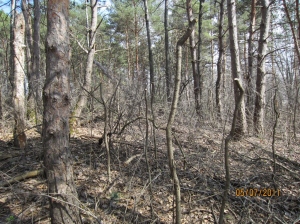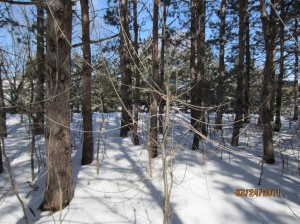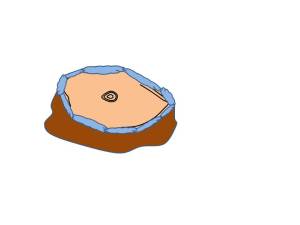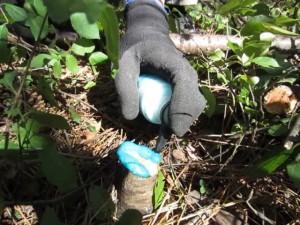Category: Uncategorized
New Products and Website Changes Coming!
In about two weeks we hope to have our new website up! We will offer several new products including the Large Foam Herbicide Dispenser. This product will be especially useful for the professional or non-professional who has a big invasive weed project.
We will also be offering an aquatic herbicide and a foaming agent. The aquatic herbicide will not have manufacturer-added surfactants. This will allow the user to add a surfactant of their choosing – for example, our foaming agent which will be a mild, non-ionic surfactant made from plant-based materials that are readily biodegradable.
Killing a Weed Tree without Herbicide
As someone working for company that sells herbicide for killing invasive plants, I get push-back from people who don’t like to use herbicides. This is understandable. When herbicides are used almost indiscriminately – killing both weeds and desirable plants, that is a huge problem. Researchers have, for example, found a loss of milkweed in agricultural fields due to increased herbicide use. Lower milkweed populations means declines in monarch butterfly populations. Pleasants et al. 2012.
If herbicides are used with precision, however, I find they can be enormously useful. For quickly eliminating harmful invasive weed trees such as buckthorn, they are indispensable, especially if you are working on a large scale. After reading numerous scientific articles over the years, I feel comfortable using them. But, I certainly respect the decision of those who choose not to use herbicides.
If you decide not to use herbicides, what is the best way to kill a weed tree? It will be tougher, and it will take at least a couple years to accomplish, but it can be done if you have patience and the number of weed trees is limited.
Here are some tips. First, don’t concoct homemade herbicides. Many people think, for example, that pouring salt on a plant is better than using a commercial herbicide. From an environmental perspective, however, you are doing much more harm than good. Herbicides like glyphosate bind tightly to soils and break down relatively rapidly. Salt, on the other hand, is very persistent in soils, and most plants do poorly in soils with high salinity. Read this article from the University of Illinois about homemade herbicides if you are tempted.
Second, be careful if you decide to pull weeds, especially large weed trees. Not only can you strain your back, you can also hurt nearby desirable plants by uprooting them. Also, freshly disturbed soils invite weed seeds. Try to minimize disturbance of soils.
Especially with weed trees, one technique I have used is repeated cuttings to weaken a plant. Timing is critical. The weed trees shown in the photo above – common buckthorn, for example, were trimmed back to what I call “tall stumps,” i.e., stumps that are above waist height or even taller if possible. I did this in the spring after they had fully leafed out. This is the time of year when the tree has sent energy from the roots to the foliage for leafing out and flowering. It’s also a time when plants are normally vigorously photosynthesizing. By trimming off all the foliage you have not only robbed a tree of much of its stored reserves, you have also harmed the tree’s ability to photosynthesize during a critical time. (You have also prevented the plant from flowering and creating seeds, which is why I trimmed these trees.)
Most invasive trees will recover. For example, buckthorn will regrow branches after a cut as shown in the photo above. The reason for cutting the tree high is two-fold. First the tree will generally grow new branches as high on the stem as possible. To weaken the tree still further, you should do another cut just below that new growth. Ideally that cut should be made in the same year – after the tree has expended energy in forming new branches. Second, another reason for cutting high and creating a tall stump is to avoid creating a bush. If you cut a stem close to the ground, multiple stems will grow from the stump. You now will have to cut multiple stems rather than just one.
It is surprising how much a well-timed trim will weaken a weed tree. I have noticed that if I top a seed-producing buckthorn it may take several years before that tree produces seeds again. In addition, I often find the sapwood of these topped trees to be discolored. This indicates to me that the tree has been stressed.
The above technique also works well even if you decide ultimately to use an herbicide. Applying an herbicide in the spring when sap is rising is generally a bad idea. By trimming and forming a tall stump in the Spring, you have eliminated at least one year of seed production. You have also weakened a tree ahead of the herbicide application and made the success of that application more likely.
Weed Trees and How to Kill by the Roots using Foam Herbicide
We posted an animated video on YouTube showing how to kill a weed tree using foam herbicide. The video also explains why foam herbicide works better than liquid herbicide for cut stump applications.
Killing Invasive Vines such as Kudzu, Oriental Bittersweet, Mile-a-Minute
Invasive vines can really take over. They primarily crowd out desirable species by shading them, but they can also girdle stems of desirable plants and cut off the free flow of plant sugars to the canopy.
To control them with herbicide, there are several things to keep in mind. First, a foliar application to vine foliage is almost always a bad idea. Usually the foliage of the vine is too intermingled with the foliage of desirable plants. Even if you can segregate the foliage of the invasive from the desirable, spraying upward where vines grow is inadvisable. You will likely end up with more spray mist on yourself than on the target vine.
Second, don’t pull the vine down from the canopy. If you do, you may do more damage to the desirable plant by breaking branches and tearing into live plant tissue (if the vine has adhesive pads that attach to stems). Focus your efforts instead on killing the vine and leaving it in place. If you want to speed its decay and to lessen strangulation of a desirable plant, cut notches into the vine stem. Again, avoid cutting the desirable plant.
Third, you will probably have better luck killing the vine if you apply the herbicide in late summer, fall, or even winter. Those are the times when the plant is translocating sugars to the roots which is also where you want the herbicide to flow.
If you want to prevent the vine from producing seeds, here is a trick that I use. After the vine has leafed out but well before it has produced fruit or seeds, cut the vine as high as you can from where it is rooted. Then allow the vine to regrow. It probably will do so vigorously with multiple new sprouts from near the cut. The trick is that you will do your treatment below this cut and new sprouts. This not only should prevent the vine from flowering and producing seeds, it will also sap the roots of energy and make the herbicide application more effective.
One way to apply herbicide is to use what is called a cut stump method (shown above). With this method, you cut the stem of the vine close to the ground – generally two to four inches above the ground from where the vine is rooted. (if the vine is rooted in multiple locations, you will need to cut and treat near each root clump.) Don’t cut so close to the ground that dirt gets on the cut face of the stump (dirt neutralizes herbicides such as glyphosate). But don’t cut too high because the treatment will be less effective. Then immediately treat the stump face with a concentrated foam herbicide. Apply the foam herbicide in a ring near the outer perimeter. You want to make sure the herbicide contacts the living plant tissue called the cambium which is just inside the outer bark. Green Shoots Foam Herbicide works great for this because you can precisely stack the foam right on the cambium and it will slowly soak in. If you wait more than about 10 to 15 minutes after cutting the stump, I would recommend re-cutting before applying the herbicide. Plants seal off wounds surprisingly quickly and this reduces the effectiveness of the herbicide. Follow the instructions on the label for the herbicide and the dispenser.
Another method is a frill treatment. With this method, you scrape or cut away some of the outer bark to expose live, inner bark as shown in the photos above. This method work especially well if the vine stem is horizontal because it provides a better surface on which to apply the herbicide. If you can try to remove bark from around the perimeter of the stem. Again, Green Shoots Foam Herbicide works great for this because the foam will cling to the frilled tissue. (Liquid herbicides on the other hand will drip right off.)
Be sure not to get herbicide on desirable plants. I even avoid getting herbicide on the outer bark of desirable plants. Although you may read that water-based herbicides won’t penetrate the protective, waxy layers of cork, it makes sense not to risk harm.
Killing Invasive Thistles and Other Weeds using Large Foam Herbicide Dispenser
This YouTube video shows how to use the new Large Foam Herbicide Dispenser from Green Shoots for spot treatments of non-woody weeds like thistles. Last month we introduced a YouTube video showing how to do spot treatments of cut stumps to kill invasive trees or shrubs. In both videos, we have attached the extension nozzle. The extension nozzle enables
precision herbicide applications thereby reducing off-target harm and herbicide waste. One added benefit of the extension nozzle: the extra reach means a lot less stooping or bending. The Large Foam Herbicide Dispenser will be offered for sale starting in the Spring of 2014.
New Large Handheld Foam Herbicide Dispenser – Launches in March, 2014
The new Large Handheld Foam Herbicide Dispenser from Green Shoots will launch in March, 2014. Two nozzles will be available: the foliar nozzle works especially well for foliar applications of foam herbicide to woody plants. the extension nozzle works well for spot treatments such as cut stump treatments. Here is a You Tube video of the Large Handheld being used for a stump treatment using triclopyr herbicide (Dowagro trade name: Garlon 3A; it is also sold under the Ortho trade name Brush-B-Gon). Triclopyr is often used for woody brush. Note in the video how precise the application with no drippage and full absorption into the stump face. The extension nozzle is approximately 15 inches long so it gives you great reach. That means less bending and stooping. If you are doing more than a couple hours of stump applications, that means a lot!
Research and Development Continues on Foam Herbicide Dispensing System Designed for Professional Users
R&D has been ongoing at Green Shoots with our next generation foam herbicide dispensing system. Our forthcoming product will be designed for professional use. More than likely, it will have a backpack tank and a wand or lance for application of the herbicide. We will keep you posted on our progress.
Lampe Presents on Rhizome Injections for Invasive Knotweed at Upper Midwest Invasive Species Conference in La Crosse, Wisconsin,
John Lampe presented at the Upper Midwest Invasive Species Conference held in La Crosse, Wisconsin, from October 29-31. The presentation was entitled: “Injection of Herbicides into Rhizomes of Knotweeds and Other Invasive Species.” (View presentation.)
This was another great conference! About 400 people attended. Experts are doing all sorts of research. One very encouraging sign is that many young people are learning about invasion biology and are now conducting cutting edge research.
Sale of Small Quatities of Concentrated Glyphosate – Ideal for cut stump and frill treatments on Woody Brush and Invasive Weed Trees
Green Shoots sells concentrated glyphosate in quanitites that are ideal for homeowners who are tackling woody brush or weed trees. We sell a 16 ounce bottle of concentrated glyphosate (41% active ingredient). Many stores sell what they call concentrated glyphosate. Don’t be fooled. Usually the concentration is well under 20%.
Especially if you are doing cut stump or frill treatments, a concentrate is essential. Glyphosate works well on plants in a concentrated form. It is almost like a quarterback blitz – glyphosate works better with a quick rush than with steady pressure. That’s why you need the concentrate.
Feel free to contact me with any questions. Just go to the Green Shoots website for contact info.
Autumn and Early Winter – Great Time to Use Herbicides to Kill Invasive Perennial Weeds such as Woody Brush, Trees, and Plants with Rhizomes using Cut-Stump, Frill, and Bend-and-Treat Techniques
Fall is generally the best time to control perennial weeds. Perennials are moving sugars from above-ground sinks – in particular foliage – to underground sinks – rhizomes and roots, for example. for overwintering. In order to kill perennial weeds, these underground sinks must be destroyed.
Fall offers other benefits as well – cooler weather, less dense foliage, and fewer bugs!
What is the best way to kill invasive perennials? Several rules hold. Apply herbicide only to living tissue. Perhaps that’s obvious. That can be green leaves or stems or vascular tissue.
Since most people are probably least familiar with vascular treatment methods, I will discuss those. Photos above show each of these methods step-by-step. One method is to do a cut stump application. With this method a weed tree is cut down and herbicide is applied to the cut-surface of the stump. For most homeowners who used water-based herbicides, you should apply the herbicide soon after the cut is made. (There is debate about how soon but I try to do it within a few minutes if possible.) Two keys to this method are: first, make the cut as close to the ground as possible (e.g., 2 to 3 inches if possible); second, make sure you apply herbicide to the outer edge of the stump just inside the bark. This will ensure herbicide gets introduced into the phloem which will carry the herbicide into the root system. The Green Shoots foam herbicide system works great with this method because the foam stays on the cut-surface and doesn’t drip down the sides of the stump.
Another method is a frill application where the tree is left standing and cuts are made into the bark of the tree. Use a knife or chisel on smaller trees and a hatchet on larger trees to make the cuts. Apply herbicide to the exposed vascular tissue. These cuts should be made as close to the ground as possible. Of the two methods, I find the cut-stump method to be the most effective. However, the frill method probably takes less work especially when you are dealing with big trees.
For green-stemmed perennial weeds, I use a slightly different method. I bend the stem near the ground and apply the herbicide at the bend. For some reason, this method works better than just cutting off the stem. I don’t know why. The Green Shoots foam herbicide system works especially well with this method because the foam sticks tightly to the bend in the stem unlike methods that use liquid herbicide. This technique can be often be used even after the leaves are nipped by frost as long as the stem is still green.
For all these methods, use a concentrated herbicide mixture. For example, if I am using a glyphosate-based herbicide, I typically use a concentration of about 35 % active ingredient.
There are a number of benefits to these methods of application. First, they are very effective. I typically have a 100% kill-rate using the Green Shoots foam herbicide system with these methods. Second, they protect the environment. The methods allow for very targeted applications. And with Green Shoots foam, the herbicide sticks well to the target surface and very little drifts through the air or drips off onto other plants.









